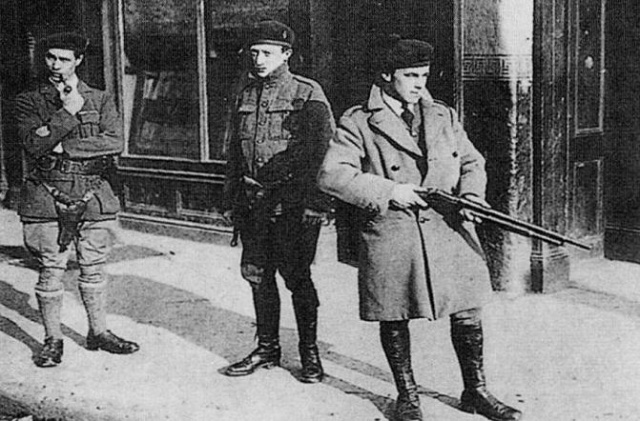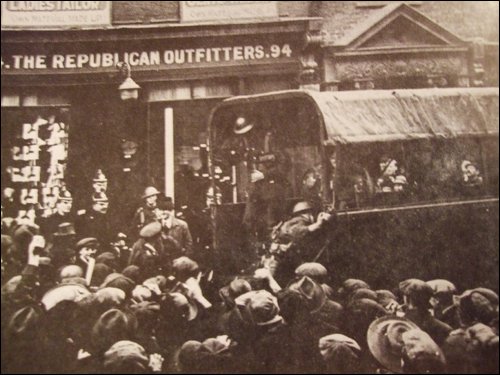At 1.50am on Saturday 16th October 1920 Peter O’Carroll and his wife Annie were awoken by a heavy and ominous knock on the front door of their home at 92 Manor Street. Mr. O’Carroll rose from his bed and reached for his trousers and stockings. A night-time military curfew was in place in Dublin and the family was becoming accustomed to such late night intrusions.
The O’Carroll home was a target of British army raids over the preceding weeks as the war between the British state and the IRA intensified. Two of the O’Carroll’s seven children were members of the IRA: Liam was Adjutant of the 1st Battalion of the Dublin Brigade, while Peter Jnr was a member of ‘A’ Company of the same Battalion.
Days previously, on 11th October, at ‘Fernside’ in Drumcondra two renowned IRA volunteers from Tipperary, Dan Breen and Seán Treacy, had shot their way out of a British army raid, killing several troops, including two senior officers, before making good their escape. Enraged at their losses and failure to capture the two IRA Volunteers, the British troops proceeded to interrogate the owner of the house, Professor O’Carolan. As he refused to divulge the names of his house guests, he was put up against a wall in the house and shot in the back of the neck. He died in hospital later that night.
Three days after his daring escape from ‘Fernside’ Seán Treacy was shot dead by British agents on Talbot Street. Treacy killed one of the agents before he was shot. Two civilians and a British soldier were also killed when the British army indiscriminately opened fire on the crowd that had gathered on the street. When the knock came on the door of 92 Manor Street the city was extremely tense. The British army seemed intent on exacting revenge for their losses in Drumcondra and Capel Street.
As the elderly Mr. O’Carroll, who was 66 years of age and in poor health, slowly and nervously made his way in darkness down the stairs, Annie peered out the front bedroom window. Unusually for such a raid, she saw the forms of just two or three men gathered at the front door. This was no ordinary raiding party. The week before a lorry load of British troops had raided the house seeking out Liam and Peter Jnr. Neither was at home and their father denied any knowledge of their whereabouts. The troops threatened that they would return; stating ominously that if his sons were not there, ‘it would be bad for him’.
Peter turned on the electric light in the kitchen and shop (the family ran a busy hardware store on Manor Street) before opening the front door. According to his daughter Martha:
All appeared absolutely quiet except for a slight movement of persons walking in the shop floor. There was a slight thud and then stillness. The light in the shop was put out, and the door from the kitchen was also pulled on the spring lock.
Concerned that her husband had not returned to bed, Annie O’Carroll crept down stairs. There she met a most appalling scene. Her husband Peter lay lifeless in a pool of blood. Gripped with terror she fled back upstairs and screamed ‘murder, murder’ from the bedroom window. A local man, who was passing by the house, heard her cries and came to her aid. They dashed around the corner to Aughrim Street church, returning with Father Turley who administered the last rites. An ambulance was called and Mr. O’Carroll was taken to Richmond Hospital where he was pronounced dead.
 He had been shot once in the side of the head. There was no evidence of a struggle. The murder gang pinned a note to his chest purporting to be from the IRA and claiming the murder. Peter O’Carroll had in fact been murdered by members of the Auxiliary Division of the RIC, a paramilitary terror gang established by the British government in July 1920 and comprised of ex-British army officers.
He had been shot once in the side of the head. There was no evidence of a struggle. The murder gang pinned a note to his chest purporting to be from the IRA and claiming the murder. Peter O’Carroll had in fact been murdered by members of the Auxiliary Division of the RIC, a paramilitary terror gang established by the British government in July 1920 and comprised of ex-British army officers.
The British government refused to allow a public inquest into Peter O’Carroll’s murder. A military inquiry was called, which the family strenuously objected to. Annie O’Carroll petitioned Dublin Corporation to hold a public inquest. In a letter to the Mayor she said:
About 1.50am on Saturday the 16th my husband, Peter O’Carroll, was foully and brutally by members of the Army of Occupation. Not content with this, they placed a label on his body, which maligned the living and defamed the dead. Myself and members of my family have been notified to attend an inquiry, which is to be held today by this same Army of Occupation. I cannot see my way to recognise this inquiry, for the simple reason that it is to be conducted by the murderers of my husband.
While the Corporation acceded to her request, the military tribunal went ahead regardless. Annie O’Carroll refused to attend. It returned a verdict that Peter O’Carroll died from shock and haemorrhage, resulting from a bullet wound inflicted by a person unknown on that day. The court was of opinion that this person unknown committed wilful murder. That owing to the omission of Mrs. O’Carroll, wife of the deceased, to obey the summons of the court to appear as a witness there is no evidence forthcoming to show under what circumstances the above wound was inflicted.
Those responsible for the murder of Peter O’Carroll were never held to account. He was buried on 20 October and so the public inquest did not go ahead.
If you know of any surviving relatives of the O’Carrolls please get in touch with us.
By Stewart
On September 6th and 7th Stoneybatter & Smithfield People’s History Project is hosting a weekend of events on Dublin tenement Life to mark the centenary of a collapse of two tenements on Church St. which killed 7 people. You can read more here.




